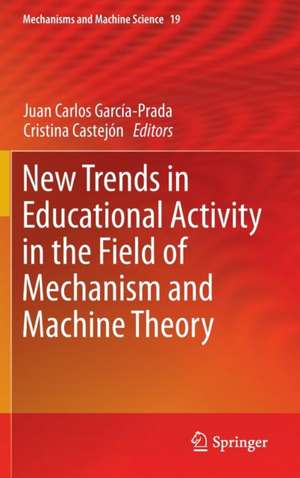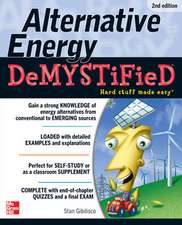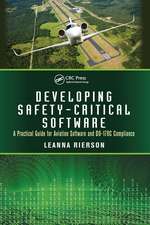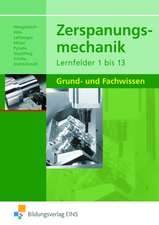New Trends in Educational Activity in the Field of Mechanism and Machine Theory: Mechanisms and Machine Science, cartea 19
Editat de Juan Carlos García-Prada, Cristina Castejónen Limba Engleză Hardback – 24 oct 2013
Topics treated include contributions on subjects such as new trends and experiences in mechanical engineering education; mechanism and machine science in mechanical engineering curricula; MMS in engineering programs, such as, for example, methodology, virtual labs and new laws.
All papers have been rigorously reviewed and represent the state of the art in their field.
| Toate formatele și edițiile | Preț | Express |
|---|---|---|
| Paperback (1) | 641.71 lei 6-8 săpt. | |
| Springer International Publishing – 27 aug 2016 | 641.71 lei 6-8 săpt. | |
| Hardback (1) | 648.05 lei 6-8 săpt. | |
| Springer International Publishing – 24 oct 2013 | 648.05 lei 6-8 săpt. |
Din seria Mechanisms and Machine Science
- 20%
 Preț: 817.43 lei
Preț: 817.43 lei - 17%
 Preț: 364.74 lei
Preț: 364.74 lei - 20%
 Preț: 1001.89 lei
Preț: 1001.89 lei - 18%
 Preț: 1268.55 lei
Preț: 1268.55 lei - 18%
 Preț: 945.79 lei
Preț: 945.79 lei - 18%
 Preț: 1275.65 lei
Preț: 1275.65 lei - 18%
 Preț: 1392.46 lei
Preț: 1392.46 lei - 18%
 Preț: 1386.17 lei
Preț: 1386.17 lei - 18%
 Preț: 2142.21 lei
Preț: 2142.21 lei - 18%
 Preț: 1382.21 lei
Preț: 1382.21 lei - 15%
 Preț: 604.87 lei
Preț: 604.87 lei - 18%
 Preț: 1104.43 lei
Preț: 1104.43 lei - 18%
 Preț: 2768.05 lei
Preț: 2768.05 lei - 18%
 Preț: 1625.27 lei
Preț: 1625.27 lei - 18%
 Preț: 1872.30 lei
Preț: 1872.30 lei - 18%
 Preț: 899.21 lei
Preț: 899.21 lei - 18%
 Preț: 1550.30 lei
Preț: 1550.30 lei - 18%
 Preț: 1832.85 lei
Preț: 1832.85 lei - 15%
 Preț: 649.87 lei
Preț: 649.87 lei - 18%
 Preț: 950.52 lei
Preț: 950.52 lei - 18%
 Preț: 953.97 lei
Preț: 953.97 lei - 18%
 Preț: 959.19 lei
Preț: 959.19 lei - 18%
 Preț: 1217.10 lei
Preț: 1217.10 lei - 18%
 Preț: 1387.73 lei
Preț: 1387.73 lei - 18%
 Preț: 1218.21 lei
Preț: 1218.21 lei - 18%
 Preț: 1546.05 lei
Preț: 1546.05 lei - 18%
 Preț: 1550.30 lei
Preț: 1550.30 lei - 18%
 Preț: 1846.73 lei
Preț: 1846.73 lei - 18%
 Preț: 1538.34 lei
Preț: 1538.34 lei - 18%
 Preț: 1000.24 lei
Preț: 1000.24 lei - 18%
 Preț: 1397.82 lei
Preț: 1397.82 lei -
 Preț: 448.88 lei
Preț: 448.88 lei - 18%
 Preț: 1233.52 lei
Preț: 1233.52 lei - 18%
 Preț: 1547.31 lei
Preț: 1547.31 lei
Preț: 648.05 lei
Preț vechi: 762.42 lei
-15% Nou
Puncte Express: 972
Preț estimativ în valută:
124.02€ • 128.74$ • 103.41£
124.02€ • 128.74$ • 103.41£
Carte tipărită la comandă
Livrare economică 22 martie-05 aprilie
Preluare comenzi: 021 569.72.76
Specificații
ISBN-13: 9783319018355
ISBN-10: 3319018353
Pagini: 324
Ilustrații: XII, 310 p. 142 illus.
Dimensiuni: 155 x 235 x 23 mm
Greutate: 0.63 kg
Ediția:2014
Editura: Springer International Publishing
Colecția Springer
Seria Mechanisms and Machine Science
Locul publicării:Cham, Switzerland
ISBN-10: 3319018353
Pagini: 324
Ilustrații: XII, 310 p. 142 illus.
Dimensiuni: 155 x 235 x 23 mm
Greutate: 0.63 kg
Ediția:2014
Editura: Springer International Publishing
Colecția Springer
Seria Mechanisms and Machine Science
Locul publicării:Cham, Switzerland
Public țintă
ResearchCuprins
Introduction.- Preface.- Part I. Mechanism and machine science in the mechanical engineer curricula.- Historical evolution of the figure of engineers and mission for their formation, by M. Ceccarelli and R. Bragastini.- Toward a curriculum in mechatronics: two experiences in Italy and Spain, by F. Bonsignorio, L. Bruzzone, and P. Fanghella.- Mechanical Engineering at a Distance: a Review, by M. Artés and J. López.- Basic projects of knowledge integration in the bachelors' degree in Industrial Technology, by S. Cardona Foix, L. Jordi Nebot, R. Pàmies-Vilà and P. Català Calderon.- Content and Realization of Mechanism Theory at RWTH Aachen University, by S. Kurtenbach, T. Mannheim, M. Hüsing and B. Corves.- Integration processes in engineering education. V. V. Kuzlyakina.- Part II. Mechanism and machine science in the engineer program: methodology.- Learning through competitive environments. Use of Robotic Simulation Environments combined with economic considerations, by J. L. Suñer Martinez and F. J. Rubio.- Service-Learning Projects in Engineering Colleges, by J. M. García-Alonso, E. Soriano, I. García-Vicario, H. Rubio.- The Modern facilities and technologies of the teaching the course to theories mechanism and machines, by V. V. Kuzlyakina.- An example on inquiry-based learning for undergraduate Mechanical Vibrations, by J.M. Chicharro, A.L. Morales, A.J. Nieto and P. Pintado.- Application of techniques based on reliability for the improvement of the teaching of mechanisms in industrial design, by J. García Sanz-Calcedo, D. Rodríguez-Salgado I. Cambero, and J.M. Herrera.- Part III. Mechanism and machine science in the engineer program: applications and research.- Optomechatronics applications of the theory of mechanisms with active student involvement in research, by V.F. Duma, A. Schitea, M. Tuef, O. Cira, C. Mnerie, Gh. Hutiu, D. Demian and I. Kaposta.- Teaching Shaft Balancing as a Parameter estimation Problem, by J. Aginaga, X. Iriarteand J. Ros.- Paradox in the Mechanisms Science, by K.S. Ivanov and K. Jilisbaeva.- Modern view on 'History of Science' teaching in technical universities, by A. Evgrafov, A. Khisamov and O. Egorova.- Multi-disciplinary optomechatronics student included research with applications in biomedical imaging, by V. F. Duma, M. L. Negrutiu, C. Sinescu, I. Voiculescu, E. Miutescu, A. Burlea, M. Vlascici and A. Gh. Podoleanu.- Analysis of dynamic systems using Bond Graph and SIMULINK, by J. A. Calvo, C. Álvarez-Caldas, J. L. San Román.- Teaching machine tools operation in virtual laboratories of Engineering Faculties, by M.J. Martín, F. Martín, C. Bermudo and L. Sevilla.- Virtual Laboratory Works on TMM, by V.B. Tarabarin, Z.I. Tarabarina, and A.G. Feygina.- Interactive Application for Technical Drawing Learning, by C. Álvarez-Caldas, J.A. Calvo, A. Quesada and J.L. San Román.- Part IV. Mechanical Engineering education: new trends.- Comparison of Geometry Software for the Synthesis and Analysis in Mechanism Theory, by S. Kurtenbach, I. Prause, C. Weigel and B. Corves.- Kinematic Analysis of Planar Mechanisms by Means of Examples, by M. Urízar, O. Altuzarra, M. Diez, F.J. Campa and E. Macho.- Teaching Mechanism and Machine Theory with Geogebra, by X. Iriarte, J. Aginaga and J. Ros .- Enhancing Mechanism and Machine Science learning by creating virtual labs with ADAMS. J. L. Suñer and J. Carballeira.- Using the think MOTION project resources for the teaching of Mechanism and Machine Theory, by V. Petuya, Ch. Pinto, J. Corral, E. Amezua and A. Hernández.- Modern view on 'History of Science' teaching in technical universities, by A. Evgrafov, A. Khisamov and O. Egorova.- Part V Mechanical Engineering education: experiences.- The experience of the University of Oviedo in the Motostudent competition. A. Noriega, R. Fernández and J.L. Cortizo.- Application of an inter-university competition on the enhancement of Engineering Degrees, by A. Fernández del Rincón, A. deJuan, P. García, M. Iglesias and F. Viadero.- Making videos to the engineer students in the middle of the Norwegian Higher Education Reform, by E. Villacorta.- Mechanism Theory in Architecture Education,by M. Barej, S. Hoffmann, G. Della Puppa, M. Hüsing, B. Corves and M. Trautz.- Interdisciplinary factory planning in the education of mechanical engineers and architects, by A. Kampker, M. Trautz, S. Kamp and I. Leufgens.- Knowledge pills for teaching of Mechanism and Machine Theory, by C. Casqueiro, R. Maceiras and A. Suárez.- Evolution of supervised work in Machine and Mechanism Theory at ETSEIB, by S. Cardona, L. Jordi Nebot, R. Pàmies-Vilà and P. Català.
Textul de pe ultima copertă
The First International Symposium on the Education in Mechanism and Machine Science (ISEMMS 2013) aimed to create a stable platform for the interchange of experience among researches of mechanism and machine science.
Topics treated include contributions on subjects such as new trends and experiences in mechanical engineering education; mechanism and machine science in mechanical engineering curricula; MMS in engineering programs, such as, for example, methodology, virtual labs and new laws.
All papers have been rigorously reviewed and represent the state of the art in their field.
Indexed in Conference Proceedings Citation Index- Science (CPCI-S)
Topics treated include contributions on subjects such as new trends and experiences in mechanical engineering education; mechanism and machine science in mechanical engineering curricula; MMS in engineering programs, such as, for example, methodology, virtual labs and new laws.
All papers have been rigorously reviewed and represent the state of the art in their field.
Indexed in Conference Proceedings Citation Index- Science (CPCI-S)
Caracteristici
New trends in mechanical engineering education Comparative study of mechanical engineering curricula in different cultures Includes experience of new educational methodologies











